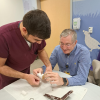Jose Morcuende, MD, PhD, doesn’t want any baby with congenital clubfoot to undergo surgery.

As the world’s leading practitioner and teacher of the nonsurgical Ponseti method, he aims to make this goal a reality.
Developed at the University of Iowa in the 1950s by Morcuende’s mentor, Ignacio Ponseti, MD, the procedure is now widely recognized as a safe and extremely effective treatment for a musculoskeletal deformity that occurs in roughly one out of every 750 babies—about 200,000 a year.
Through his work at Iowa and as director of the nonprofit Ponseti International Association, Morcuende has trained more than 1,000 orthopedic specialists and care providers worldwide to apply the Ponseti method.
“When the casting is done, the foot has remarkably close-to-normal flexibility,” says Morcuende, who came to Iowa to work with and learn from Ponseti. When Ponseti died in 2009 at age 95—he continued to see patients in his clubfoot clinic at UI Hospitals & Clinics until the end of his life—Morcuende assumed the role as advocate, advisor, and educator on the Ponseti method.
The procedure involves the gentle manipulation of an infant’s feet through the application of a series of plaster casts and braces. It has a success rate of over 90% over just five to six weeks—without a lifetime risk of pain, weakness, and reduced range of motion that can result from corrective surgery.
For the Ponseti method to be effective, it has to be administered accurately, which is why Morcuende is dedicated to educating and training others.
“It’s a very specific way of stretching and very specific way of doing the cast,” Morcuende says. “It’s as precise as surgery because of the complexity of the foot and leg.”
While leading group-training sessions on the Ponseti method in the early 2000s, Morcuende and colleagues realized that proper training required time, precision, and practice. Soon, providers were embedded with the Iowa team as they did their work. Since then, more than 300 doctors have traveled to Iowa City for clubfoot training, with the majority coming from other countries.
“They spend two weeks with us, and I can dedicate my whole attention to making sure they understand the method. When they leave, they know how to do the casting properly for different kinds of cases,” Morcuende says.
Morcuende has also traveled to more than 60 countries to train doctors on the Ponseti method and observe their clubfoot clinics in action. He’s also helped establish clubfoot programs in other nations by working with physicians, parents, and governmental agencies.
Through these collaborations, as many as 1 million children have been treated over the past two decades using the Ponseti method.
And Morcuende remains determined to keep going.
“When doctors see the method, they understand the value of it,” he says. “If we can keep training doctors, and keep saving these kids from surgery, that’s the value in the work we do.”